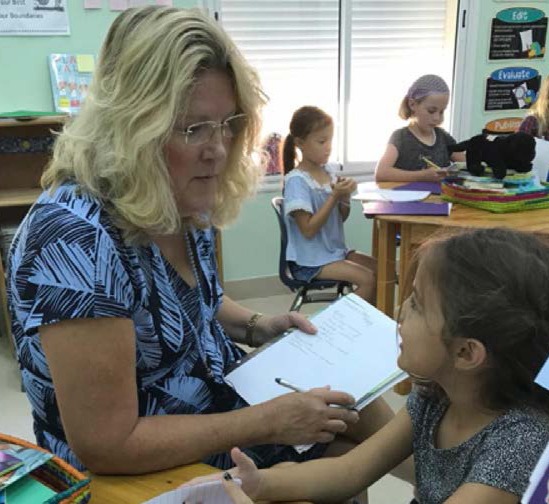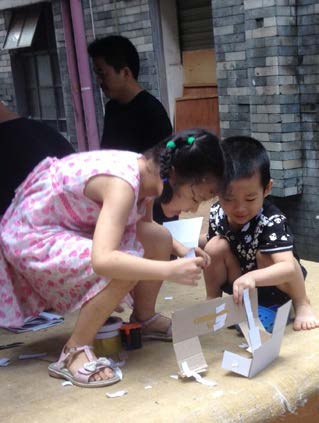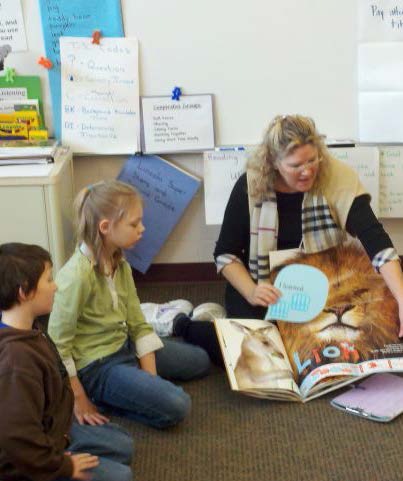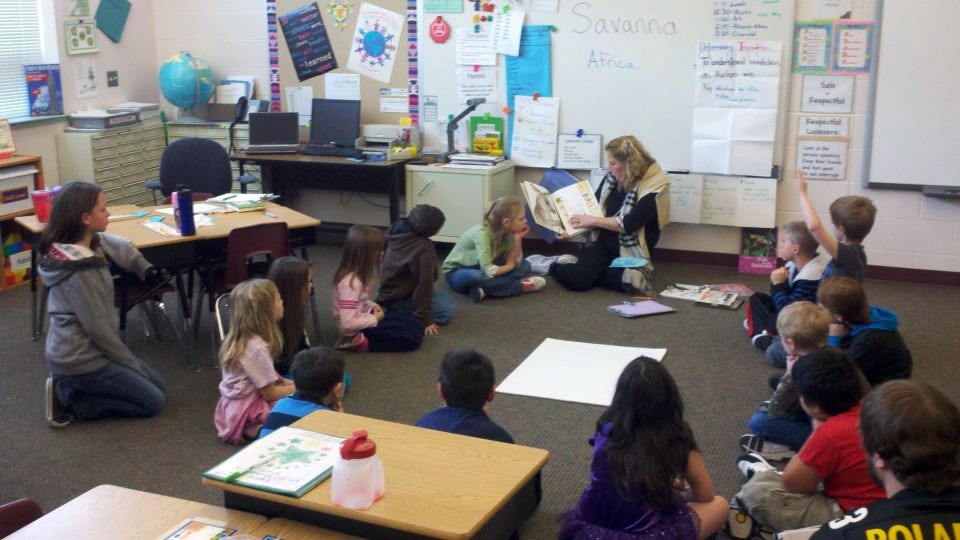Puzzles, Stories, and Show & Tell: Teaching Students the Language of Thinking
March 2018
Laura Benson
Director of Curriculum and Professional Development
A puzzle. A conundrum. A big fat juicy problem to solve. Watching small and tall children over the last four decades, I learned that curiosity is the rocket fuel of learning. Children’s sense of wonder ignites them to be the most brilliant and brave problem solvers. This law of nature was once again affirmed for me on a Sunday in Shenzhen, China several years ago.
Having recently moved to Southeast China, my new colleagues took me to a local art market. The art was compelling, for sure, but I found myself magnetically drawn to a pair of children creating their own art.
For the four hours we prowled the stalls of the Darfen Art Market, these two young artists built a number of sculptures trying a number of methods and materials until they achieved satisfaction. The preschool innovators were completely devoted to their art puzzles – without any adults needed – and powered with the energy of their own very focused sense of creative problem solving.
Reading is lot like the constructive puzzling of the young Darfen artists. Reading is problem-solving (Vinton, 2017). Lifting the ink from the page of a book and transforming those black dots and squiggles into thoughts? Miraculous problem-solving! Making sense of the recorded words of another person? Complete brain fireworks show of interpretations and resolutions!
How can we craft reading instruction to tap into children’s natural problem-solving disposition? Whether taking an inductive (Barnhouse & Vinton, 2012; Vinton, 2017) or deductive approach (Harvey & Ward, 2017) to teaching, here’s what reading as thinking sounds like as you sit in the nest of Readers’ Workshop classrooms.

Model Thinking with Students
Share your ways of understanding with students. Voice your internal meaning making dialogue. For example, as students and I read a lot of mysteries and poems, I demonstrate how I work to understand by inferring with self-talk such as “I bet…” or “I think that maybe…because the text said…” The language I use primes, prompts and patterns the thinking of my students (Ritchhart, 2002 & 2015). This self-talk modeling of thinking may come from me or from a student. It’s our way of creating a brain show and tell (Benson, 2002) together to make the thinking of readers more concrete, more relevant, and more inviting for all.
This kind of reading-as-thinking teaching deprivatizes literacy learning for students of all ages. When many of us were growing up, we were told to read. But we were never shown or told how. In order for students to do excellent work, they have to know what excellent work sounds like (Wiggins, 1997).
So, work to help your students gain vivid soundtracks of how readers talk to themselves to understand texts before, during, and after they read.
To plan for your modeling, keep a notepad by your nightstand or wherever you do most of your reading. When you notice a way of thinking, a strategy you use to create meaning as you read, jot it down. Once you have even a small bundle of these notes, you have a pool of lesson plans and conference coaching tips.
Looking over your own ways of understanding, which one/s would be the next easiest thinking step/s and the most interesting thinking strategy/ies for your students to try in their own reading? Drawing from my own reading well and knowing my students really well are two key ways I determine and develop responsive learning journeys for growing thinkers (Benson, 2003).
Of course, the goal of our modeling is always to help students understand what they read. So, take care in modeling your ways of understanding. As Vicki Vinton (2017) advises, I believe that considering and constructing an understanding of a text’s meaning should be the purpose of reading, rather than practicing a strategy or skill or meeting a particular standard. Thus, while I hand over my ways of understanding to students through my modeling, these are invitations and 36 possibilities but not hard assignments. I strive to not set an agenda for students as they read independently.
Our teaching has to put students in the driver’s seat of their own reading and not take away their sense of discovery and ownership. Expecting kids to discover their own best ways of understanding is paramount in nurturing our students as independent, eager, and self-fueled thinkers.


Encourage Students to Notice and Name Their Thinking
An edifying piece I share with students of all ages comes from the brilliant and gritty writer Gary Paulsen from his book The Winter Room:
If books could be more, could show more, could own more,
this book would have smells…this book would have sounds…
this book would have light…But books can’t have light (and sounds and smells). If books could have more, give more, be more, show more, they would still need readers, who bring to them sound and smell and light and all the rest that can’t be in books. The book needs you.
From this piece, the kids and I talk about “How does the book need us?” For the rest of the school year, this is our touchstone – Thinking about thinking. Figuring out what each book needs us to do to understand it. Reflecting on his thinking of a current mystery, Kamil shared ‘My book needs me to keep thinking “What next? What’s going to happen to the character next?” This makes you want to keep turning the pages!’
And Zahra burst forth with the following discovery from her reading of multiple texts, “It’s like we are Sherlock Holmes, Mrs. B! We just look for the clues (in the book) to solve our mystery! I figured out a lot today – I think I know who stole the jewelry in this one!”
Responding to Zahra, I shared, “How exciting! That is such a great way to describe thinking, Zahra. And I know exactly what you mean. That’s just what it feels like when I read The Girl on the Train. There are so many clues from the author and I have to put these clues together to solve the mystery of this story – Like I am Sherlock Holmes!”

Nurture Thinking as Students Read Independently
As students read on their own during our Readers’ Workshop or in any content area class, I sit with individual students to engage in conferences. I often begin with a question such as “Tell me about your thinking” (Benson, 2004) or “Can you tell me what’s going on here?” (Vinton, 2017). Nurturing thinking dispositions, I am very intentional with my conferring. My most common conferring ritual is a 3-step process to with a very natural conversation feel – Listen, Name, Nudge.
I listen to determine how the student is working to understand what he/she is reading, the student or I name an effective way of understanding he/she is using well, and I nudge the student to take on the next easiest and most supportive strategy or skill of thinking to understand.
Sometimes, the best nudge is to encourage the student to continue using the named way of thinking so that it becomes a habit of understanding (And these conferences do not have to be very long to be hugely helpful in supporting students’ thinking.).
Reflect on Thinking with Students
As John Dewey shared, “We do not learn from experience, we learn from reflecting on our experiences.” Thus, to help students become intentional thinkers, I often close our Readers’ Workshop with a Talking Circle.
I initiate the conversation with questions such as “What did you notice today as you read?” or “What did you learn about yourself today as a thinker (or reader) today?” Even with young children, they quickly find ways to reflect on and voice their ways of thinking (For very young children, you can frame this reflection around how the kids worked to understand as they listened to you read to them.).
Apprenticing growing readers and writers, the kids are constantly my very best mentors. Teaching as storytelling, telling students the story of my thinking to ignite their insights about their own thinking, I also expect to learn more about thinking from students. It’s kind of like going to book club each month. My reading of the chosen title is rich with the details of my understanding. But after talking with my book club mates, my understanding of the book is vastly larger in scope blossomed with new insights shared in our conversation.
As a community of readers, for my students and I, reading together and talking about our reading regularly expands our understanding of the texts we read and of our ways of working to understand, too.
Whether students are reading in literacy classes or for content area studies, our responsive thinking38 focused teaching can help students define reading as thinking, give them opportunities to discover and name ways of understanding, and offer them continuous apprenticeship experiences as we model our thinking and invite students to demonstrate their thinking aloud with one another.
Knowing how to think as readers, as learners, as friends makes understanding possible and compelling for our students. We can live Gary Paulsen’s advice as you create a thinking community with our students where each child understands how books need us.
BIBLIOGRAPHY
- Benson, Laura. (2004). Deep Thinking: Sustaining Students’ Strategy Learning to Cultivate Their Independence. The Colorado Communicator, (27), 72 – 87.
- Benson, Laura. (2003). Drawing From Our Well: Creating Writing Lessons from Our Reading Journeys, Part One. Colorado Reading Council Journal. (26), 18 – 24.
- Benson, Laura. (2002). Strategy Collections for Growing Readers and Writers and Their Growing Teachers. The Colorado Communicator. Denver, CO: IRA.
- Benson in Almeida, et al. (2011). Standards and Assessment: The Core of Quality Instruction. Englewood, CO: Lead + Learn Press.
- Harvey, Stephanie and Ward, Annie. (2017). From Striving to Thriving: How to Grow Confident, Capable Readers. New York NY: Scholastic.
- Paulsen, Gary. (1989). The Winter Room. Dell Publishing: New York.
- Ritchhart, Ron. (2015). Creating Cultures of Thinking: The 8 Forces We Must Master to Truly Transform Our Schools. San Francisco, CA: Jossey-Bass.
- Tovani, Cris and Moje, Elizabeth Birr. ( 2017). No More Telling as Teaching: Less Lecture, More Engaged Learning (Not This but That). Portsmouth, NH: Heinemann.
- Vinton, Vicki. (2017). Dynamic Teaching for Deeper Reading: Shifting to a Problem-Based Approach. Portsmouth, NH: Heinemann.
- Wiggins, Grant. (1997). Understanding by Design workshop.






